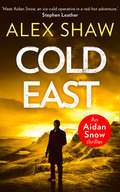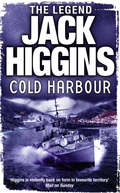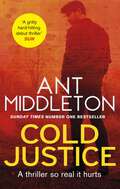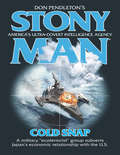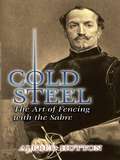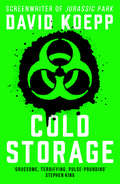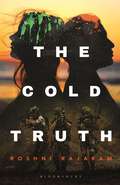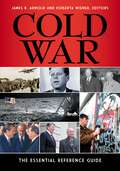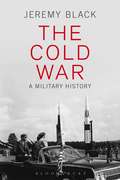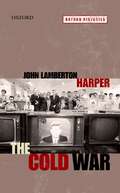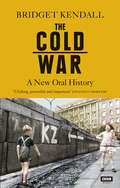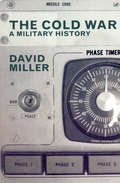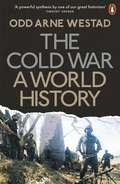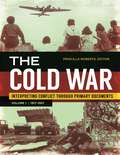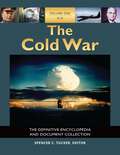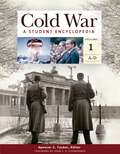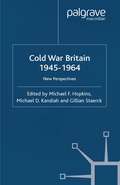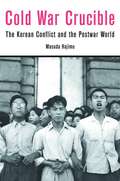- Table View
- List View
Cold East (An Aidan Snow SAS Thriller #3)
by Alex ShawThe clock is ticking. Will Aidan Snow be able to save the world…again?
Cold Harbour (Dougal Munro And Jack Carter Ser. #2)
by Jack HigginsAn explosive World War Two adventure from the author of THE EAGLE HAS LANDED set on the eve of D-Day.
Cold Justice: The thriller of the year from the bestselling superstar of SAS: Who Dares Wins (Mallory)
by Ant Middleton***PRE-ORDER YOUR COPY NOW OF THE BIGGEST THRILLER OF THE YEAR***It's here: the landmark debut thriller from superstar Ant Middleton, million-selling, number one Sunday Times author of First Man In and The Fear Bubble and star of SAS: Who Dares Wins.Mallory - he was the best of the best, a Special Forces leader and a hero. But then he made a fatal decision, gambling with the lives of his men with terrible consequences: two dead, and his young friend Donno left in a coma. Back on the streets, with nothing to lose, Mallory has a darkness growing inside him, a dangerous need to seek out trouble. Then Donno's mother asks him for help: her other son, Scott, has gone missing in South Africa, and she wants Mallory to find him.Perhaps it's redemption, perhaps he's looking for revenge on the world, but suddenly Mallory has a purpose, and nothing and no one is going to stand in his way.A THRILLER SO REAL IT HURTS.
Cold Snap
by Don PendletonThe covert teams of Stony Man Farm battle terrorist threats few know exist. Operating under the President, these elite warriors and cybertech experts are bound by honour and ready to sacrifice their lives to protect the innocent, overseas or on U.S. soil.
Cold Steel: The Art of Fencing with the Sabre (Dover Military History, Weapons, Armor Ser.)
by Alfred Hutton Ramon MartinezA pioneer of modern fencing, Alfred Hutton was the first president of the Amateur Fencing Association and a father of modern research into the Western combat arts. In addition to his lectures about ancient weapons and his demonstrations of their use, Hutton created this 1889 classic, a continuing source of instruction and enlightenment to modern readers.The techniques associated with the sabre differ markedly from those of the épeé and the rapier. This study offers both technical and historical views of the art of the sabre. It begins with a look at the weapon's construction and its grip, followed by explanations of a variety of different strokes and parries as well as methods of combining attack and defense. Additional topics include approaches suitable for left-handed fencers, ceremonial aspects of the art, and contrasts between the sabre, the bayonet, and the French sword. Descriptions of associated weapons cover the great stick and the constable's truncheon, and the book concludes with considerations of the short sword-bayonet, or dagger. Fifty-five illustrations demonstrate how to hold the sabre, how to parry and guard, seizure, and numerous other aspects of the art of fencing with a sabre.
Cold Storage: A Novel
by David Koepp‘Gruesome, terrifying, pulse-pounding, and also pretty goddamn funny in places. You need to get on this right away.’ Stephen King ‘Jurrassic Park screenwriter Koepp’s jaunty debut … it’s Michael Crichton with laughs’Financial Times
The Cold Truth
by Roshni RajaramColonel Nitesh Sharma is a highly respected commanding officer of the 37 Int & FS Unit. Only Sandhya, his wife, knows that he is compulsively abusive husband. The violence escalates when she begins to question Nitesh's past marriages, specifically the first one that left him a widower…Having escaped her vicious marriage, Sandhya settles in her new life as a journalist in Delhi. She proves to be a hard worker, and along the way rekindles old friendships. Few people know of what she's endured in the past. However, this peace is disrupted by a court case involving her now ex-husband Col Sharma. Things begin to unravel. And fast.In the highly masculine environment of the army, Sandhya has to shape her own identity and life, by facing her worst nightmares. When she accidentally discovers a scandal that threatens to destroy the Indian army, she has no choice but to take on the most dreaded adversaries to protect its reputation. Along the way, the story recounts the dedication of our military, the honour and sacrifice of our soldiers, and relationships that are tested by the powerful forces of courage and resolve.
Cold War: The Essential Reference Guide
by James R. Arnold Roberta WienerThe impact of the Cold War is still being felt around the world today. This insightful single-volume reference captures the events and personalities of the era, while also inspiring critical thinking about this still-controversial period.Cold War: The Essential Reference Guide is intended to introduce students to the tensions between the Soviet Union and the United States that dominated international affairs in the second half of the 20th century. A comprehensive overview essay, plus separate essays on the causes and consequences of the conflict, will provide readers with the necessary context to understand the many facets of this complex era.The guide's expert contributors cover all of the influential people and pivotal events of the period, encompassing the United States, the Soviet Union, Europe, Southeast Asia, China, the Middle East, Latin America, and Africa from political, military, and cultural perspectives. Reference entries offer valuable insight into the leaders and conflicts that defined the Cold War, while other essays promote critical thinking about controversial and significant Cold War topics, including whether Ronald Reagan was responsible for ending the Cold War, the impact of Sputnik on the Cold War, and the significance of the Prague Spring.
Cold War: The Essential Reference Guide (Library Of Modern American History Ser.)
by James R. Arnold Roberta Wiener Dr Valerie Adams Dr Dewi I. Ball Lacie A. Ballinger Dr Jakub Basista Robert G. Berschinski Frank Beyersdorf Anna Boros-McGee Christopher John Bright Colonel George M. Brooke III Barry Carr Phillip Deery Dr Bruce J. DeHart Dr Jérôme Dorvidal Dr Timothy C. Dowling Jaroslav Dvorak Dr Lee W. Eysturlid Dr Richard M. Filipink Jr. Dr Philipp Gassert Beatrice De Graaf Magarditsch Hatschikjan Kurt Heinrich James J. Hentz John C. Horn Dr Donna R. Jackson A. Ross Johnson Brian Madison Jones Dr Melissa Jordine Robert S. Kiely Dr Arne Kislenko Jonathan H. L’Hommedieu Dr Jeffrey A. Larsen Daniel Lewis Arturo Lopez-Levy Dr Lorenz M. Lüthi Dr Jerome V. Martin Dr James I. Matray A. Gregory Moore Caryn E. Neumann Dr Christian Nuenlist Dr Vernon L. Pedersen Allene Phy-Olsen Dr Paul G. Pierpaoli Jr. Dr Michael Richards Dr Priscilla Roberts Bevan Sewell Colonel Charles G. Simpson Dr Larry Simpson Sarah B. Snyder Dr Daniel E. Spector Dr David Tal Dr Aviezer Tucker Dr Spencer C. Tucker Josh Ushay Joseph Robert White Dr James H. Willbanks Law Yuk-FunThe impact of the Cold War is still being felt around the world today. This insightful single-volume reference captures the events and personalities of the era, while also inspiring critical thinking about this still-controversial period.Cold War: The Essential Reference Guide is intended to introduce students to the tensions between the Soviet Union and the United States that dominated international affairs in the second half of the 20th century. A comprehensive overview essay, plus separate essays on the causes and consequences of the conflict, will provide readers with the necessary context to understand the many facets of this complex era.The guide's expert contributors cover all of the influential people and pivotal events of the period, encompassing the United States, the Soviet Union, Europe, Southeast Asia, China, the Middle East, Latin America, and Africa from political, military, and cultural perspectives. Reference entries offer valuable insight into the leaders and conflicts that defined the Cold War, while other essays promote critical thinking about controversial and significant Cold War topics, including whether Ronald Reagan was responsible for ending the Cold War, the impact of Sputnik on the Cold War, and the significance of the Prague Spring.
The Cold War: A Military History
by Jeremy BlackThe term the Cold War has had many meanings and interpretations since it was originally coined and has been used to analyse everything from comics to pro-natalist policies, and science fiction to gender politics. This range has great value, but also poses problems, notably by diluting the focus on war of a certain type, and by exacerbating a lack of precision in definition and analysis. The Cold War: A Military History is the first survey of the period to focus on the diplomatic and military confrontation and conflict.Jeremy Black begins his overview in 1917 and covers the 'long Cold War', from the 7th November Revolution to the ongoing repercussions and reverberations of the conflict today. The book is forward-looking as well as retrospective, not least in encouraging us to reflect on how much the character of the present world owes to the Cold War. The result is a detailed survey that will be invaluable to students and scholars of military and international history.
The Cold War: A Military History
by Jeremy BlackThe term the Cold War has had many meanings and interpretations since it was originally coined and has been used to analyse everything from comics to pro-natalist policies, and science fiction to gender politics. This range has great value, but also poses problems, notably by diluting the focus on war of a certain type, and by exacerbating a lack of precision in definition and analysis. The Cold War: A Military History is the first survey of the period to focus on the diplomatic and military confrontation and conflict.Jeremy Black begins his overview in 1917 and covers the 'long Cold War', from the 7th November Revolution to the ongoing repercussions and reverberations of the conflict today. The book is forward-looking as well as retrospective, not least in encouraging us to reflect on how much the character of the present world owes to the Cold War. The result is a detailed survey that will be invaluable to students and scholars of military and international history.
The Cold War (Oxford Histories)
by John Lamberton HarperThe East-West struggle for supremacy from 1945 to 1989 shaped the lives of hundreds of millions and brought the world to the brink of disaster on several occasions. More than two decades on, the debate over its causes and dynamics is far from over. Drawing on the latest archival evidence and scholarly research, prize-winning historian John Lamberton Harper provides a concise, briskly-written assessment of the Cold War. Why did it start, and eventually envelope nearly every corner of the planet? Why did it stay "cold," at least in its original, European theatre? Why did it end, and who should take the credit? Harper illuminates the deep-seated behavioural patterns within both the Soviet Union and the United States: the search for security through expansion and military might, the belief in a "messianic" mission to uplift humanity, but also a readiness to live and let live based on membership in a common state system and a shared interest in survival. He stresses ways in which internal competitions for political power tilted both the U.S. and Soviet systems towards bellicosity and obsessive preparation for a hot war that no one seriously intended to begin. It is a story of delusions of omnipotence and rash behavior, punctuated by moments of redeeming statesmanship and self-restraint. Harper concludes that, rather than triumphalism, a clear look back at the Cold War's close calls with catastrophe and enormous cost in lives and treasure ought to evoke a sense of regret and humility, as well as relief.
The Cold War: A New Oral History of Life Between East and West
by Bridget KendallThe Cold War is one of the furthest-reaching and longest-lasting conflicts in modern history. It spanned the globe - from Greece to China, Hungary to Cuba - and lasted for almost half a century. It has shaped political relations to this day, drawing new physical and ideological boundaries between East and West. In this meticulously researched account, Bridget Kendall explores the Cold War through the eyes of those who experienced it first-hand. Alongside in-depth analysis that explains the historical and political context, the book draws on exclusive interviews with individuals who lived through the conflict's key events, offering a variety of perspectives that reveal how the Cold War was experienced by ordinary people. From pilots making food drops during the Berlin Blockade and Japanese fishermen affected by H-bomb testing to families fleeing the Korean War and children whose parents were victims of McCarthy's Red Scare, The Cold War covers the full geographical and historical reach of the conflict. The Cold War is essential reading for anyone seeking to understand how the tensions of the last century have shaped the modern world, and what it was like to live through them.
The Cold War: A Military History
by David MillerFrom 1949 to 1991 the world was overshadowed by the Cold War. Repeatedly it seemed that in days, even hours, global nuclear conflict would sweep away much of the United States, the Soviet Union and Europe. They would be obliterated in what President Carter described as 'one long, final and very bleak afternoon'. When the Cold War ended, the Warsaw Pact was wound up and the vast military forces which had flourished for over forty years were disbanded. As with all wars, however, it was only then that the realities of what had been involved began to emerge; indeed, much has remained hidden until now.In The Cold War, David Miller discloses not only the vast scope of the military resources involved, but also how nearly threat came to terrible reality. Most chillingly of all, he reveals that while the menace of nuclear war predominated, it was actually little understood even by the experts. The book examines each military area in turn, covering the formation of the two great alliances, and the strategies and major weapons in the rival navies, armies and air forces. That the Cold War ended without a conflict was due to professionalism on both sides. The result, Miller suggests, would have impressed the Chinese military strategist, Sun Tsu, who, writing in the fifth century BC, said that 'to subdue the enemy without fighting is the acme of skill'.
The Cold War: A World History
by Odd Arne Westad'Odd Arne Westad's daring ambition, supra-nationalist intellect, polyglot sources, masterly scholarship and trenchant analysis make The Cold War a book ofresounding importance for appraising our global future as well as understanding our past' Richard Davenport-Hines, TLS, Books of the YearAs Germany and then Japan surrendered in 1945 there was a tremendous hope that a new and much better world could be created from the moral and physical ruins of the conflict. Instead, the combination of the huge power of the USA and USSR and the near-total collapse of most of their rivals created a unique, grim new environment: the Cold War.For over forty years the demands of the Cold War shaped the life of almost all of us. There was no part of the world where East and West did not, ultimately, demand a blind and absolute allegiance, and nowhere into which the West and East did not reach. Countries as remote from each other as Korea, Angola and Cuba were defined by their allegiances. Almost all civil wars became proxy conflicts for the superpowers. Europe was seemingly split in two indefinitely.Arne Westad's remarkable new book is the first to have the distance from these events and the ambition to create a convincing, powerful narrative of the Cold War. The book is genuinely global in its reach and captures the dramas and agonies of a period always overshadowed by the horror of nuclear war and which, for millions of people, was not 'cold' at all: a time of relentless violence, squandered opportunities and moral failure.This is a book of extraordinary scope and daring. It is conventional to see the first half of the 20th century as a nightmare and the second half as a reprieve. Westad shows that for much of the world the second half was by most measures even worse.
The Cold War [2 volumes] [2 volumes]: 2 volumes [2 volumes]
by Priscilla RobertsThis detailed two-volume set tells the story of the Cold War, the dominant international event of the second half of the 20th century, through a diverse selection of primary source documents.One of the most extensive to date, this set of primary source documents studies the Cold War comprehensively from its beginning, with the emergence of the world's first communist government in Russia in late 1917, to its end, in 1991. All of the key events, including the Berlin Blockade, the Korean War, the Cuban Missile Crisis, the Vietnam War, and the nuclear arms race, are discussed in detail. The primary sources provide insight into the thinking of all participants, drawing on Western, Soviet, Asian, and Latin American perspectives.In The Cold War: Interpreting Conflict through Primary Documents primary documents are organized chronologically, allowing readers to appreciate the ramifications of the Cold War within a clear time frame. Extensive interpretive commentary provides in-depth background and context for each document. This work is an indispensable reference for all readers seeking to become deeply knowledgeable about the Cold War.
The Cold War [2 volumes] [2 volumes]: 2 volumes [2 volumes]
This detailed two-volume set tells the story of the Cold War, the dominant international event of the second half of the 20th century, through a diverse selection of primary source documents.One of the most extensive to date, this set of primary source documents studies the Cold War comprehensively from its beginning, with the emergence of the world's first communist government in Russia in late 1917, to its end, in 1991. All of the key events, including the Berlin Blockade, the Korean War, the Cuban Missile Crisis, the Vietnam War, and the nuclear arms race, are discussed in detail. The primary sources provide insight into the thinking of all participants, drawing on Western, Soviet, Asian, and Latin American perspectives.In The Cold War: Interpreting Conflict through Primary Documents primary documents are organized chronologically, allowing readers to appreciate the ramifications of the Cold War within a clear time frame. Extensive interpretive commentary provides in-depth background and context for each document. This work is an indispensable reference for all readers seeking to become deeply knowledgeable about the Cold War.
The Cold War [5 volumes]: The Definitive Encyclopedia and Document Collection [5 volumes]
by Dr Spencer C. TuckerThis sweeping reference work covers every aspect of the Cold War, from its ignition in the ashes of World War II, through the Berlin Wall and the Cuban Missile Crisis, to the collapse of the Soviet Union in 1991.The Cold War superpower face-off between the Soviet Union and the United States dominated international affairs in the second half of the 20th century and still reverberates around the world today. This comprehensive and insightful multivolume set provides authoritative entries on all aspects of this world-changing event, including wars, new military technologies, diplomatic initiatives, espionage activities, important individuals and organizations, economic developments, societal and cultural events, and more. This expansive coverage provides readers with the necessary context to understand the many facets of this complex conflict.The work begins with a preface and introduction and then offers illuminating introductory essays on the origins and course of the Cold War, which are followed by some 1,500 entries on key individuals, wars, battles, weapons systems, diplomacy, politics, economics, and art and culture. Each entry has cross-references and a list of books for further reading. The text includes more than 100 key primary source documents, a detailed chronology, a glossary, and a selective bibliography. Numerous illustrations and maps are inset throughout to provide additional context to the material.
The Cold War [5 volumes]: The Definitive Encyclopedia and Document Collection [5 volumes]
This sweeping reference work covers every aspect of the Cold War, from its ignition in the ashes of World War II, through the Berlin Wall and the Cuban Missile Crisis, to the collapse of the Soviet Union in 1991.The Cold War superpower face-off between the Soviet Union and the United States dominated international affairs in the second half of the 20th century and still reverberates around the world today. This comprehensive and insightful multivolume set provides authoritative entries on all aspects of this world-changing event, including wars, new military technologies, diplomatic initiatives, espionage activities, important individuals and organizations, economic developments, societal and cultural events, and more. This expansive coverage provides readers with the necessary context to understand the many facets of this complex conflict.The work begins with a preface and introduction and then offers illuminating introductory essays on the origins and course of the Cold War, which are followed by some 1,500 entries on key individuals, wars, battles, weapons systems, diplomacy, politics, economics, and art and culture. Each entry has cross-references and a list of books for further reading. The text includes more than 100 key primary source documents, a detailed chronology, a glossary, and a selective bibliography. Numerous illustrations and maps are inset throughout to provide additional context to the material.
Cold War [5 volumes]: A Student Encyclopedia [5 volumes]
The most comprehensive and up-to-date student reference on the Cold War, offering expert coverage of all aspects of the conflict in a richly designed format, fully illustrated to give students a vivid sense of life in all countries affected by the war.ABC-CLIO is proud to announce the latest addition to its widely acclaimed legacy of historical reference works for students. Under the direction of internationally known expert Spencer Tucker, Cold War: A Student Encyclopedia captures the vast scope, day-to-day drama, and lasting impact of the Cold War more clearly and powerfully than any other student resource ever published.Ranging from the end of the Second World War to the collapse of the Soviet Union, Cold War: A Student Encyclopedia offers vivid portrayals of leading individuals, significant battles, economic developments, societal/cultural events, changes in military technology, and major treaties and diplomatic agreements. The nearly 1,100 entries, plus topical essays and a documents volume, draw heavily on recently opened Russian, Eastern European, and Chinese archives. Enhanced by a rich program of maps and images, it is a comprehensive, current, and accessible student reference on the dominant geopolitical phenomenon of the late-20th century.
Cold War Britain (Cold War History)
by M. Hopkins M. Kandiah G. StaerckBritain and the Cold War, 1945-1964 offers new perspectives on ways in which Britain fought the Cold War, and illuminates key areas of the policy formulation process. It argues that in many ways Britain and the United States perceived and handled the threat posed by the Communist bloc in similar terms: nevertheless, Britain's continuing global commitments, post-war economic problems and somestic considerations obliged her on occasion to tackle the threat rather differently.
Cold War Crucible: The Korean Conflict and the Postwar World
by Masuda HajimuAfter World War II, the major powers faced social upheaval at home and anti-colonial wars around the globe. Alarmed by conflict in Korea that could change U.S.-Soviet relations from chilly to nuclear, ordinary people and policymakers created a fantasy of a bipolar Cold War world in which global and domestic order was paramount, Masuda Hajimu shows.
Cold War Crucible: The Korean Conflict and the Postwar World
by Masuda HajimuAfter World War II, the major powers faced social upheaval at home and anti-colonial wars around the globe. Alarmed by conflict in Korea that could change U.S.-Soviet relations from chilly to nuclear, ordinary people and policymakers created a fantasy of a bipolar Cold War world in which global and domestic order was paramount, Masuda Hajimu shows.
Cold War Delta Prototypes: The Fairey Deltas, Convair Century-series, and Avro 707 (X-Planes)
by Tony ButtlerAt the dawn of the supersonic jet age, aircraft designers were forced to devise radical new planforms that suited the new power of the jet engine. One of the most successful was the delta wing. Although Gloster produced the delta wing Javelin, and Boulton Paul –its P.111 research aircraft – Fairey and Avro were the champions of the delta in Britain. Meanwhile in America, with the exception of Douglas's Navy jet fighter programmes, Convair largely had the delta wing to itself. These development lines, one on each side of the Atlantic, had essentially the same objective – to produce high-speed fighter aircraft. In Britain, the Fairey Delta 2 went on to break the World Air Speed Record in spectacular fashion, but it failed to win a production order. In contrast Convair received major orders for two jet fighter types and one jet bomber. At the same time, the British Avro company built the 707 family of research aircraft, which led to the famous Vulcan, to show how the delta wing could be adopted for a highly successful subsonic bomber. This book examines the development of the delta wing in Britain and America, and the way in which experimental aircraft like the Fairey Deltas proved their potential and versatility. In Britain it covers the Fairey Delta 1 and Fairey Delta 2, the proposed Fairey Delta Rocket Fighter and huge Delta 3 long range interceptor, and the Avro 707. On the American side, it examines the Convair XF-92 and XF-92A, the development of the Delta Dagger/Delta Dart family, and the Convair Sea Dart – the world's only supersonic seaplane.
Cold War Delta Prototypes: The Fairey Deltas, Convair Century-series, and Avro 707 (X-Planes #15)
by Tony ButtlerAt the dawn of the supersonic jet age, aircraft designers were forced to devise radical new planforms that suited the new power of the jet engine. One of the most successful was the delta wing. Although Gloster produced the delta wing Javelin, and Boulton Paul –its P.111 research aircraft – Fairey and Avro were the champions of the delta in Britain. Meanwhile in America, with the exception of Douglas's Navy jet fighter programmes, Convair largely had the delta wing to itself. These development lines, one on each side of the Atlantic, had essentially the same objective – to produce high-speed fighter aircraft. In Britain, the Fairey Delta 2 went on to break the World Air Speed Record in spectacular fashion, but it failed to win a production order. In contrast Convair received major orders for two jet fighter types and one jet bomber. At the same time, the British Avro company built the 707 family of research aircraft, which led to the famous Vulcan, to show how the delta wing could be adopted for a highly successful subsonic bomber. This book examines the development of the delta wing in Britain and America, and the way in which experimental aircraft like the Fairey Deltas proved their potential and versatility. In Britain it covers the Fairey Delta 1 and Fairey Delta 2, the proposed Fairey Delta Rocket Fighter and huge Delta 3 long range interceptor, and the Avro 707. On the American side, it examines the Convair XF-92 and XF-92A, the development of the Delta Dagger/Delta Dart family, and the Convair Sea Dart – the world's only supersonic seaplane.
